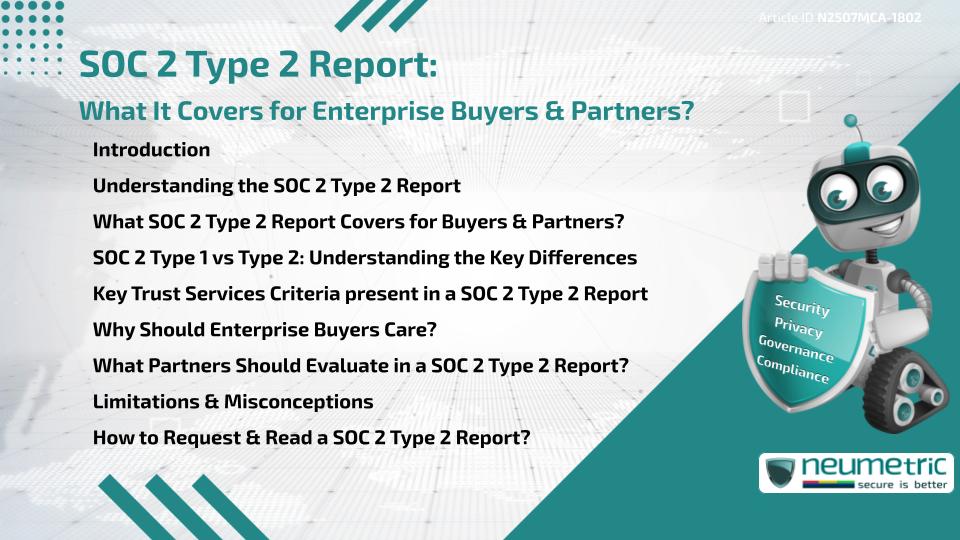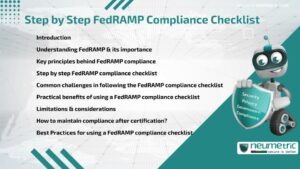Table of Contents
ToggleIntroduction
When evaluating a new B2B SaaS provider or cloud-based service partner, enterprise buyers & partners often ask a critical question—can we trust their security practices? The answer often lies in a document known as the SOC 2 Type 2 report. This detailed Audit report evaluates how well an Organisation implements & maintains internal controls related to Data Security & Privacy.
More than just a checkbox for Compliance, a SOC 2 Type 2 report serves as a trust document for potential customers & Stakeholders, especially in highly regulated or Risk-conscious industries.
Understanding the SOC 2 Type 2 Report
A SOC 2 Type 2 report is an assurance document issued after an independent Audit by a certified public accounting firm. It evaluates an Organisation’s internal controls related to one or more of the Trust Services Criteria—Security, Availability, Processing Integrity, Confidentiality & Privacy—over a review period, typically lasting three (3) to twelve (12) months.
Unlike a Type 1 report, which assesses whether controls are correctly designed at a point in time, the Type 2 variant goes further. It verifies not just control design but actual operational effectiveness over time.
For a foundational overview, the American Institute of CPAs (AICPA) offers guidance on SOC reporting standards.
What SOC 2 Type 2 Report Covers for Buyers & Partners?
Buyers & partners rely on the SOC 2 Type 2 report to understand:
- Whether the service provider has clearly defined security practices.
- How well those practices are implemented over time.
- Evidence of effective monitoring, detection & response processes.
- The maturity of Risk Management strategies in real-world operations.
For instance, when a cloud service provider asserts 99.9% availability, the Audit report will include logs, tests & controls that verify this level of uptime throughout the Audit period. This gives buyers proof that commitments are more than marketing claims.
SOC 2 Type 1 vs Type 2: Understanding the Key Differences
People often mix up the two types of SOC 2 reports. Verification of right systems & controls in place on a specific date is given by SOC 2 Type 1 report. It is useful during early-stage relationships or pre-launch scenarios.
The SOC 2 Type 2 report, on the other hand, is far more powerful because it confirms whether those controls were consistently followed & operated effectively across time.
Key Trust Services Criteria present in a SOC 2 Type 2 Report
The report is structured around one or more of the following criteria, depending on the Organisation’s scope:
- Security: Protection of data & systems from unauthorised access.
- Availability: Whether systems are accessible as agreed upon.
- Processing Integrity: Completeness & accuracy of data processing.
- Confidentiality: Protection of confidential business information.
- Privacy: Responsible use & disclosure of Personal Data.
Most SOC 2 Type 2 reports include security by default. Enterprises should verify which other criteria are addressed in the report to ensure alignment with their Risk posture.
The Cloud Security Alliance also supports broader discussions on these controls in cloud environments.
Why Should Enterprise Buyers Care?
For enterprise buyers, a SOC 2 Type 2 report helps reduce Third Party Risk. It acts as:
- Evidence of thorough efforts to comply with regulatory requirements or internal policies.
- Evidence for vendor Risk Assessment workflows.
- A way to identify any control gaps or areas that need mitigation
Without this kind of report, procurement teams in organisations must depend on self-reported statements or unclear policies, which can pose significant risks in industries such as finance, healthcare or legal technology.
What Partners Should Evaluate in a SOC 2 Type 2 Report?
Strategic partners & resellers reviewing a SOC 2 Type 2 report should look beyond the summary. Key sections worth evaluating include:
- System Description: Outlines the scope & services covered.
- Auditor’s Opinion: Indicates if controls were suitably designed & operated effectively.
- Exceptions & Deviations: Lists control failures or areas needing improvement.
- Complementary User Entity Controls (CUECs): These are controls that you, the partner or Customer, are expected to implement on your end.
Limitations & Misconceptions
Despite its significance, the SOC 2 Type 2 report has certain limitations like:
- It is not a certification. It is an attestation based on an Audit.
- It does not guarantee future security or Compliance.
- Reports are usually confidential & may only be shared under NDA.
- They represent a snapshot of past performance, not a future guarantee.
Also, some companies may cherry-pick what systems are included in the report scope, leaving critical gaps unnoticed.
How to Request & Read a SOC 2 Type 2 Report?
Enterprise teams can request a SOC 2 Type 2 report directly from the Vendor’s security team. It is common to sign a non-disclosure agreement [NDA] before receiving the document.
When reading the report:
- Focus on control objectives & how they are mapped to actual controls.
- Look for any listed exceptions & how they were mitigated.
- Review whether the controls apply to the specific services you intend to use.
Takeaways
- A SOC 2 Type 2 report verifies control effectiveness over time, not just design.
- Enterprise buyers should use it as a key Risk & Compliance evaluation tool.
- Strategic partners should understand what is in the report & what is not.
- The report supports informed decisions around trust, Data Security & vendor onboarding.
FAQ
Why do companies need SOC 2 Type 2 report?
It helps enterprise customers & partners evaluate the effectiveness of a service provider’s Data Security & operational controls over time.
How much time does a SOC 2 Type 2 report remain valid?
It usually covers a review period of three (3) to twelve (12) months & remains valid until the next Audit cycle is completed.
Is a SOC 2 Type 2 report mandatory?
It is not legally required, but highly recommended in sectors like Finance, Healthcare or SaaS where Customer Data is a core asset.
Is it possible for a company to fail in a SOC 2 Type 2 Audit?
Yes. If critical controls are not implemented or fail during the review period, the Auditor’s opinion may be qualified or negative.
Does a SOC 2 Type 2 report include Customer responsibilities?
Yes. It includes Complementary User Entity Controls [CUECs] that outline what customers must do to maintain overall security posture.
How does SOC 2 Type 2 relate to ISO 27001?
Both focus on Information Security, but ISO 27001 is a certification while SOC 2 Type 2 is an Audit-based attestation over a specific time period.
Can startups get a SOC 2 Type 2 report?
Yes, though it takes time. Startups usually begin with a Type 1 report, then mature into Type 2 readiness as operations stabilise.
Need help?
Neumetric provides organisations the necessary help to achieve their Cybersecurity, Compliance, Governance, Privacy, Certifications & Pentesting goals.
Organisations & Businesses, specifically those which provide SaaS & AI Solutions, usually need a Cybersecurity Partner for meeting & maintaining the ongoing Security & Privacy needs & requirements of their Clients & Customers.
SOC 2, ISO 27001, ISO 42001, NIST, HIPAA, HECVAT, EU GDPR are some of the Frameworks that are served by Fusion – a centralised, automated, AI-enabled SaaS Solution created & managed by Neumetric.
Reach out to us!





